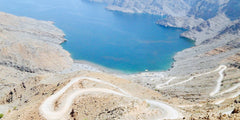

After 7 years of overcast skies, light drizzle in London and flat beer, the thought of sun and warmth among the sands and waters of Abu Dhabi was intoxicating. What could be better than sunshine 360 days a year?
I wanted to explore my new home in the Middle East - the hundreds of miles of untouched sand dunes in the empty quarter, islands of the Arabian Gulf, the Al Hajar mountains in Oman and the United Arab Emirates (“UAE”), the rugged peninsula of Musandam, to name a few - all within a day’s drive. Yet a day’s drive could be treacherous in a land where temperatures exceed 105’ Fahrenheit six months a year, often hitting 120’ F. The region can be one of the most unforgiving places on the planet. Don't believe me? Try eating outside in August!

I took ample advice on how to prepare for these trips - my SUV was mechanically sound, I traveled with another car or alerted friends where I was traveling, always carried at least 3 liters of water per passenger, and I packed a bugout bag with all my must have survival gear for the Middle East.

My bag had all the car-focused items - tow ropes, jumper cables, air compressor, flat tire repair kits - but it also contained several mylar thermal blankets to reflect the sun’s rays, a folding shovel for getting unstuck from deep sand, a first aid kit, sunscreen, work gloves, non-perishable energy bars, and a few flashlights.
Like most bags on the market, my bag was generally comprehensive with a variety of tools. But it only took one serious situation for me to realize that while I had everything on the checklist, there was still more that needed to be done. I learned that my bag was a mess. Components were disorganized, and thrown together in a large duffle bag. When seconds counted, it took me way too long to find the pieces I needed.
The close call that brought this to my attention happened early May in Oman, and we were hiking to explore the hanging gardens in Al Buraimi - we’d left at dawn to try to beat the heat. Temperatures had already marched above 105F by mid morning and we began bouldering down our descent. As we slowly descended, one of our group misstepped, Paul stepped into a crevice. He had a deep gash down to the shin bone, and was bleeding pretty hard. We tied an extra t-shirt around the wound and struggled down to the cars. By the time we reached the cars, Paul was light headed, possibly dehydrated and ready pass out.
I started searching through my emergency bag, looking for the first aid kit and some electrolyte tablets, eventually dumping the bag on the ground. I needed to get Paul into some makeshift shade using mylar blankets and paracord. We couldn’t put him in the car because the interior was a furnace - 160F. Precious moments went by as I struggled to find what I was looking for among the contents scattered on the ground.
I eventually found what I needed to stabilize Paul. As I drove out of the desert to the hospital, I knew bag needed better organization.
The Seventy2 solves for this - we designed it to be well organized - all components are clearly labeled and fit easily into marked compartments. Pull the insert out, and it unfolds to clearly display all the life-saving components, for quick and easy access. The insert not only provides a clean surface to work from, but can be carried as a backpack on its own, or it can be carried inside the shell backpack.

My experiences in the Middle East helped us design the Seventy2, an expert reviewed kit. As our team compared notes on essential survival items for bugout bags, it became apparent to us that the emergency needs around the world tend to have some common themes - We include these key components that can cover you across a multitude of situations, whether they arise in the USA or the UAE. Check out what the Seventy2 has to offer.